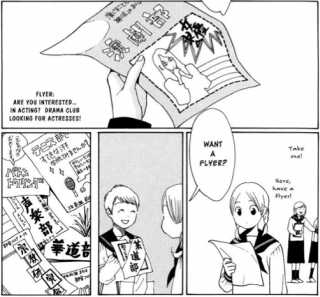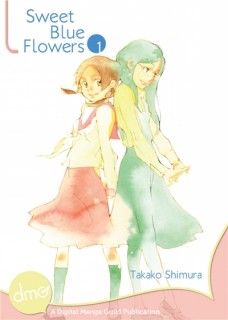Earlier this year my good friend Jocilyn Wagner contributed a review of Hiroki Ugawa’s Shrine of the Morning Mist, Volume 1 to Experiments in Manga. She was recently inspired to do so more manga blogging and to write another review, and so I’m happy to welcome Jocilyn back to Experiments in Manga! This time she’ll be taking a look at the Digital Manga Guild edition of Sweet Blue Flowers, Volume 1 by Takako Shimura.
* * *
Easily Shimura Takako’s most well-known manga endeavour, Sweet Blue Flowers is an unforgettable bildungsroman of the classic Japanese girl’s school (minus the dorm boarding). The story focuses on two heroines: Manjoume Fumi and Okudaira Akira. Childhood friends who were separated for elementary and junior high and by coincidence have moved into the same neighborhood together for high school. The girls, who don’t at first recognize each other, are reintroduced when Akira (called “Aki” in this version) saves the timid Fumi from train molestation. Although the two attend different schools, their close friendship and shared interest in acting cause Fumi to find excuses to attend theatre club at Aki’s much more wealthy/prestigious school.
The setting of two close-knit girls’ schools often lends itself to a Yuri manga and Sweet Blue Flowers positively embraces the plot line. As the story opens, Fumi (tall and bashful) is recovering from her separation with Chizu, Fumi’s first love, a cousin who’s getting married. Enter in the dashing heartbreaker Sugimoto Yasuko who’s been recently cast against her will as the swoon-worthy Heathcliff. Yasuko is immediately smitten of Fumi and Fumi is quick to return her feelings (…perhaps too quick?). Despite being easily embarrassed and a worrier, Fumi manages to confide the relationship and her sexuality in Aki. The level-headed Aki doesn’t really understand why this would be a problem but ponders the issue while Fumi, who’s assumed it will come between them slips into fear-induced avoidance of her. When Aki’s finally able to snag Fumi aside she asks her, “What can I do to support you?”
Sweet Blue Flowers is as wonderful and poignant in English as it is in Japanese. The story is moving and rapturous. I’m really hopeful DMP can publish Sweet Blue Flowers in print…
But now I think I have a better understanding of why they might not. Compared to Fantagraphics’ Wandering Son, this version of Aoihana is frankly an embarrassment that in no way lives up to the beauty of the original and really shouldn’t be printed as is. It’s in desperate need of an English adapter and some real copy editing. As a Shimura fangirl, I really want to see Aoihana in print, so just in case the project leader is listening, the following is a substantial critique. The optimist should stop reading here. :)
The biggest problem in my mind is that bizarrely, instead of how it’s always been rendered “Ah-chan” in both the original manga AND the anime near and dear by now to the hearts of North Americans, this version replaces all the Ah-chans with “Aki.” To be fair, Aki is more of a fleshed out name than Ah-chan, but it’s really a boy’s name and it doesn’t suit Akira’s character, besides which it’s not a name Shimura-sensei chose. Part of what makes Aoihana so cute is that the Okudaira siblings have their names reversed: that is to say, Akira is usually though not always a boy’s name and Shinobu is similarly a girl’s name occasionally used for boys. Perhaps the idea here with “Aki” was to emphasize that her name doesn’t fit the image? Yet I think Shimura-sensei would argue that’s exactly why she’s always been called Ah-chan (to make up for/ignore the more masculine Akira). Put simply, Akira is always called Ah-chan because she’s ridiculously cute and her role in the story is to be the best friend and onee-chan from Fumi’s childhood, thus someone you’d want to give a cute nickname to like “Ah-chan.” Perhaps because she’s given a bit more wisdom than other characters or because of her future role in the story, the DMG team chose to call her Aki. At any rate, it feels like an awkward and unnecessary change that will stick out painfully to most fans of the work.
Additionally, there’s just too much left untranslated in terms of signage with parenthetical notes given instead that really detract from the flow of the reading. As far as I can tell, all the signs and documents are left untranslated (even ones that couldn’t possibly be hurt by replacement with English such as the heading card in the photo album scrapbook that reads “Christmas Party” or the words on the cake for Chizu’s party) which comes off looking like the typesetter just couldn’t be bothered/too inexperienced to handle the job. For the none-Japanese reader it’s too much work to constantly be hunting for marginalia. Shimura’s penmanship isn’t all that legible anyway (most were drawn with marker), so if you can read Japanese, leaving the signs as is doesn’t necessarily help things–except in the case of one of her school gateway engravings, it doesn’t exactly have a “Shoudo” quality. Perhaps the concept here is to give the English reader a sense that they’re really in Kamakura, but that’s actually doing Shimura-sensei a disservice as the gorgeous well-researched setting she’s drawn is more stark and striking than most mangaka can muster.

Add to this a lot of really tiring typographical errors such as “Pap” for “Pat” and “Beautiful is Youth” “Hasegawwa” and “Fajisawa”, really detract from the reading experience. The emanga version of Sweet Blue Flowers is very welcome and we love you for it, but please consider further editing before sending it to the printer.
In terms of the digital file, it’s definitely topknotch. Emanga allows you to choose from among seven or eight major formats as well as offering you the option of reading your books through their proprietary online reader. I was really happy to be able to get Sweet Blue Flowers in PDF since it looks and functions the best on the iPad. It’s not always the most annotation friendly, but since manga is an artistic medium it makes sense to use an Adobe format to access it. Unfortunately, once you’ve chosen to download the file in one format, you’re stuck with only that single file type and you’d need to repurchase it from emanga to get it in a different format (DRM is kinda evil like that). I had no trouble downloading the file and it opens great on all my devices. Given their many options for downloading, their pricing system that’s free from points and rentals and their interface with Amazon, I’d highly recommend emanga over some other digital manga sites I’ve tried (except when it comes to editing).

 MJ: As BL discussions have cropped up in comments over the past couple of weeks, both in the
MJ: As BL discussions have cropped up in comments over the past couple of weeks, both in the  I’m inclined to believe it’s a little of both, and I agree pretty strongly on the first bit. Though I haven’t been a fan of SuBLime’s licenses, they crush DMP so far in terms of both visual quality and ease of delivery. While manga delivered by way of DMP’s iPad app looks like a million bucks, their Kindle releases are far from it (see
I’m inclined to believe it’s a little of both, and I agree pretty strongly on the first bit. Though I haven’t been a fan of SuBLime’s licenses, they crush DMP so far in terms of both visual quality and ease of delivery. While manga delivered by way of DMP’s iPad app looks like a million bucks, their Kindle releases are far from it (see  MICHELLE: My experience is pretty different, as I own neither smartphone nor tablet. All I have is a Kindle—which, as mentioned, is useless for manga—and a personal computer. Still, I am not peeved at all by the move toward digital distribution.
MICHELLE: My experience is pretty different, as I own neither smartphone nor tablet. All I have is a Kindle—which, as mentioned, is useless for manga—and a personal computer. Still, I am not peeved at all by the move toward digital distribution. My greatest BL highlight of the year was absolutely JManga’s release of Setona Mizushiro’s
My greatest BL highlight of the year was absolutely JManga’s release of Setona Mizushiro’s  Speaking of Kinoshita, she’s been a favorite of mine since I read the first volume of Kiss Blue several years ago, but her work is suddenly all over the place here, thanks mainly to the Digital Manga Guild, who brought us (among others)
Speaking of Kinoshita, she’s been a favorite of mine since I read the first volume of Kiss Blue several years ago, but her work is suddenly all over the place here, thanks mainly to the Digital Manga Guild, who brought us (among others)  Like you, most of SuBLime’s licenses don’t really appeal to me, but that doesn’t mean I haven’t been able to find titles to enjoy.
Like you, most of SuBLime’s licenses don’t really appeal to me, but that doesn’t mean I haven’t been able to find titles to enjoy.  In my review, I wrote, “There are so many things to recommend this manga. The atmosphere is sort of… elegant and languid, which suits mysterious Mizuki well and makes an earnest everydude like Asada stand out all the more. The growing friendship between the men is believable—and they’re both completely professional adults, I might add—as is Mizuki’s wary reaction when Asada confesses his feelings.. It’s lovely and complicated, and when the guys do finally get together physically it’s wonderfully awkward.”
In my review, I wrote, “There are so many things to recommend this manga. The atmosphere is sort of… elegant and languid, which suits mysterious Mizuki well and makes an earnest everydude like Asada stand out all the more. The growing friendship between the men is believable—and they’re both completely professional adults, I might add—as is Mizuki’s wary reaction when Asada confesses his feelings.. It’s lovely and complicated, and when the guys do finally get together physically it’s wonderfully awkward.”
















